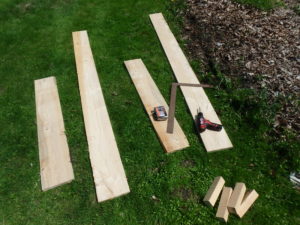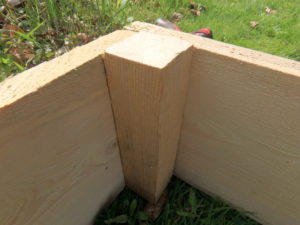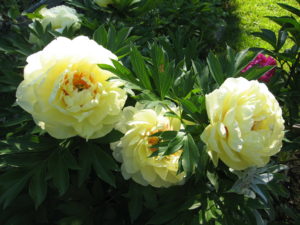Tips for Building Raised Beds for Your Garden
As an avid gardener I am always looking for new places to plant. I own a couple of acres of land, but over the past 49 years I’ve filled virtually every square inch of useable space with something – vegetables, flowers, trees and a little lawn. Recently I built a wood-sided raised bed to give me more room for flowers.
Raised beds are good for many reasons:
- The lawn can’t so easily creep into them.
- You can design/blend the soil to be anything you want – sandy, rich or heavy; acidic, neutral or alkaline.
- They drain well, even if built over a soggy base.
- You can place them on the lawn without needing to remove the sod (it will die off).
I built a raised bed recently using rough sawn hemlock I bought from a local sawyer. Rough sawn must means that the wood is cut, but not planed. So a 1”x 8” plank is a full inch thick, not the ¾ inch that you would get at a lumber yard or home center – and hence stronger, and longer lasting.
Hemlock is full or resins that resist rot. It is not as good as cedar, but it is much cheaper. You can buy planed cedar that is a full inch thick, it is called “five-quarter”, and is available at most places that sell lumber. But it’s pricey. You can use plain old pine boards from the lumber yard, but they tend to rot sooner.
Then there is pressure treated wood and synthetic boards made from re-cycled pop bottles that is said to last 50 years or so. Years ago pressure treated wood leached arsenic into the soil, but newer technologies have eliminated that as a problem, I have read. Still, I am personally leery of using it for any food or herbs. I try to avoid chemicals whenever possible.
What size bed should you build? That depends on your space and the reach of your arms. I am relatively tall, so I made my bed 4 feet wide. Smaller people might be more comfortable weeding or planting a bed that is just 3 feet wide. I made mine 8 feet long, but 10 feet or even 6 feet might suit you – or your space – better.
Here’s how I built mine: I cut 2 hemlock boards 8 feet long for the sides, and 2 boards 4 feet long for the ends. Then I cut a piece of wood 2 inches by 2 inches into 8-inch long sections, 4 of them. You can use a 2-by-4 instead of 2 by 2 if you have one.
Instead of using nails I find it easier to work with screws. I used some that were an inch and a half long. Driving screws into dense wood like hemlock or cedar can strain a drill. If you find that the screws don’t easily go all the way in, you can pre-drill holes a little smaller in diameter than the screws. Or you can lubricate the screws by dragging them across a bar of soap (moisten it a little to soften it). That helps a lot.
Those 8-inch pieces of 2 x 2 are for the corners, to make them sturdy, square, and to allow the screws to bite into something more substantial than a 1-inch plank. I screwed them onto the ends of the long planks, then stood up the planks and screwed the short planks into the corner pieces. That is easier to do if you have someone helping you, but you can always lean the long planks against something to keep them vertical if you are working alone.
If you don’t feel handy or don’t have a saw, you can buy brackets that will hold either a 2-inch or 1-inch thick planks. Gardener’s Supply Company sells a variety of brackets designed for 2-inch thick lumber, and Lee Valley Tools has just one type and it is for 1-inch thick lumber (from a lumber yard, so they won’t work on the thicker rough sawn lumber I used). Both companies make nice products, and will ship to your door. Your local lumber yard will cut the boards you need to the length you want. Just ask.
I started this project because I wanted to give perfect soil and sunlight to a new peony I bought from Cider Hill Gardens in Windsor, Vermont. It is one called “Garden Treasure”, an Itoh peony. These peonies are crosses of regular herbaceous peonies with tree peonies.
Itoh peonies can bloom in colors other peonies could not even dream of: yellow with peach, for example. And they can bloom for a full month, producing 50 blossoms or more at maturity. But they are expensive, so I have never gotten one – until this year.
In that same bed I am moving some old daffodils that have stopped blooming. Nearly 50 years ago I dug some old bulbs from my parents’ home in Woodbridge, Connecticut and moved them to my home in New Hampshire. In recent years the leaves have appeared, but not any blossoms.
Those daffodils have been growing in a place that is getting shadier each year and there is more root competition, too. So I will dig them up and move them into this new bed, which offers full sun. I will also treat them to a dose of Bulb Booster to enrich their soil. What I do to pamper my plants!
Reach Henry at henry.homeyer@comcast.net or P.O. Box 364, Cornish Flat, NH 03746. Please include a SASE if wishing a response by mail.





